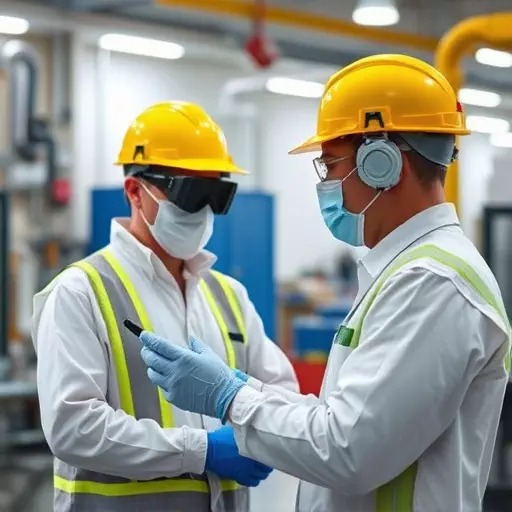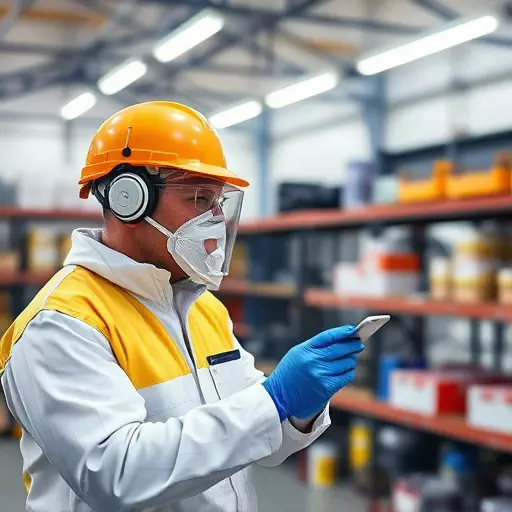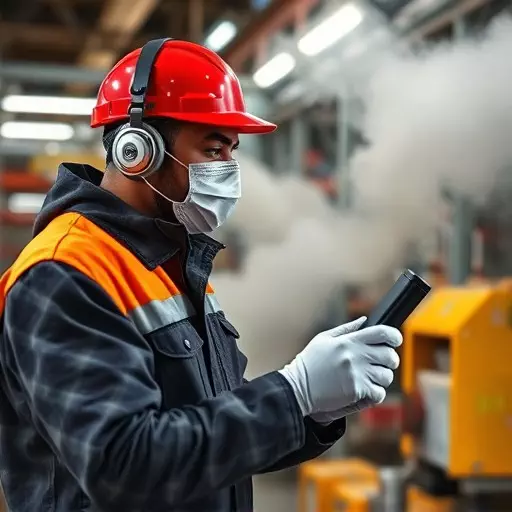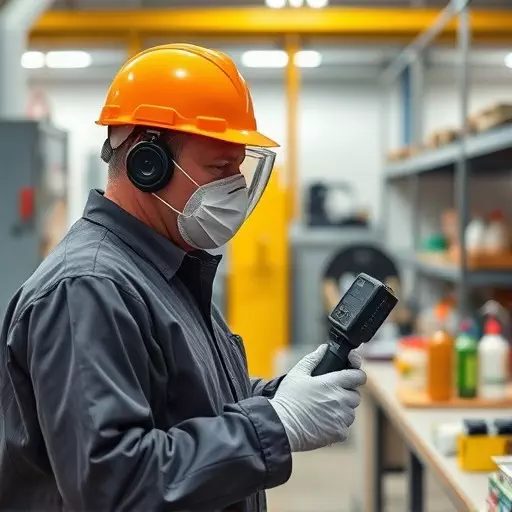Employee exposure monitoring is crucial for maintaining workplace safety in manufacturing, focusing on regular workplace air quality testing and hazardous substance monitoring. These practices help identify and mitigate risks from pollutants and harmful gases, ensuring compliance with regulations. Advanced technologies like real-time sensors enable continuous tracking, allowing manufacturers to implement effective controls, protect employees, and enhance operational efficiency while fostering a safer work environment.
In manufacturing, ensuring worker safety through comprehensive employee exposure monitoring is paramount. This article delves into critical aspects of industrial hygiene, exploring how regular assessments, workplace air quality testing, and hazardous substance monitoring can identify and mitigate risks. We discuss advanced technologies enhancing safety measures and the vital role of regulatory compliance. Additionally, we provide best practices for implementing effective exposure monitoring programs, empowering manufacturers to foster a safer work environment.
- Understanding Employee Exposure Monitoring: The Need for Regular Assessment
- Workplace Air Quality Testing: Uncovering Hidden Dangers
- Hazardous Substance Monitoring: Identifying and Mitigating Risks
- Advanced Technologies in Exposure Monitoring: Enhancing Safety
- Regulatory Compliance and Its Role in Protecting Workers
- Best Practices for Implementing Effective Exposure Monitoring Programs
Understanding Employee Exposure Monitoring: The Need for Regular Assessment

Employee exposure monitoring is a critical aspect of ensuring workplace safety and health. It involves regular assessment and measurement of employees’ exposure to various hazards, including airborne contaminants, toxic substances, and other potential risks. These assessments are essential for identifying and mitigating risks before they cause harm.
Workplace air quality testing and hazardous substance monitoring are key components of employee exposure monitoring. Regular testing helps maintain optimal workplace air quality by detecting and quantifying pollutants or harmful gases. This data allows manufacturers to implement necessary controls, such as improving ventilation systems or switching to safer materials, thereby reducing employee exposure to dangerous substances. Consistent monitoring ensures that safety measures remain effective over time and helps comply with regulatory requirements.
Workplace Air Quality Testing: Uncovering Hidden Dangers

Workplace Air Quality Testing is an essential component of comprehensive employee exposure monitoring. In many manufacturing environments, invisible hazards lurk in the air, posing significant risks to workers’ health and safety. These hazardous substances, ranging from toxic chemicals to harmful particles, can accumulate over time, often going unnoticed without proper testing. Regular workplace air quality assessments help identify these hidden dangers by measuring concentrations of various pollutants, ensuring compliance with occupational health standards.
By conducting such tests, manufacturers can gain valuable insights into the air quality within their facilities. This data enables them to take targeted actions, including implementing control measures, improving ventilation systems, and introducing personal protective equipment. Proactive hazard monitoring not only protects employees from potential illnesses but also fosters a safer, more productive work environment, ultimately contributing to better overall manufacturing outcomes.
Hazardous Substance Monitoring: Identifying and Mitigating Risks

In manufacturing, employee exposure monitoring is a critical component of ensuring workplace safety and health. Hazardous substance monitoring involves identifying and assessing exposure to airborne contaminants, chemicals, and other risks that may be present in the manufacturing environment. Regular workplace air quality testing plays a pivotal role in this process by providing data on the levels of hazardous substances in the air, helping to pinpoint potential sources of danger and evaluate their impact on employees’ health over time.
By implementing these monitoring practices, manufacturers can mitigate risks effectively. It allows them to take appropriate measures such as improving ventilation systems, implementing engineering controls, providing personal protective equipment (PPE), and training employees on safe work practices. Continuous employee exposure monitoring enables proactive management of workplace hazards, fostering a safer and healthier manufacturing environment.
Advanced Technologies in Exposure Monitoring: Enhancing Safety

Advanced technologies are transforming employee exposure monitoring in manufacturing, significantly enhancing safety standards and workplace air quality testing. Tools like real-time air quality sensors and wearable exposure monitors allow for continuous tracking of hazardous substances, enabling immediate action when thresholds are exceeded. These innovations go beyond traditional methods, which often relied on periodic sampling and laboratory analysis, leading to potential delays in identifying risks.
By integrating these advanced technologies, manufacturers can proactively manage workplace environments. Data-driven insights facilitate informed decision-making regarding ventilation systems, personal protective equipment (PPE), and safety protocols. This proactive approach not only protects employees from health risks but also contributes to overall operational efficiency by minimizing downtime and ensuring compliance with stringent environmental regulations.
Regulatory Compliance and Its Role in Protecting Workers

In the manufacturing industry, ensuring worker safety and compliance with regulations is paramount. Employee exposure monitoring plays a crucial role in this regard by identifying and mitigating risks associated with hazardous substances present in the workplace. Regular workplace air quality testing is an integral part of this process, as it helps to quantify and assess the levels of potential hazards in the air workers breathe. By implementing these practices, manufacturers can meet regulatory standards set forth by governing bodies concerned with occupational health and safety.
Compliance with regulations goes beyond legal requirements; it underscores a commitment to fostering a safe and healthy work environment. Effective hazardous substance monitoring enables employers to take proactive measures, such as implementing engineering controls, providing personal protective equipment, and instituting rigorous training programs. This multifaceted approach not only protects workers from potential exposure but also fosters a culture of safety and accountability within the organization.
Best Practices for Implementing Effective Exposure Monitoring Programs

Implementing an effective exposure monitoring program is crucial for maintaining optimal workplace air quality and ensuring employee safety, especially when dealing with hazardous substances. Best practices involve a multi-faceted approach that combines regular workplace air quality testing, continuous monitoring of exposure levels, and proactive risk assessment. Conducting periodic assessments helps identify potential hazards and allows manufacturers to take prompt corrective actions.
Integrating employee exposure monitoring into the safety regimen requires utilizing advanced technologies like air sampling devices, personal protective equipment (PPE) with built-in sensors, and data analytics platforms. These tools enable real-time tracking of airborne contaminants, facilitating timely interventions. Moreover, establishing clear protocols for data collection, analysis, and communication ensures that all stakeholders are aware of potential risks, enabling proactive measures to mitigate exposure and maintain a healthy work environment.


